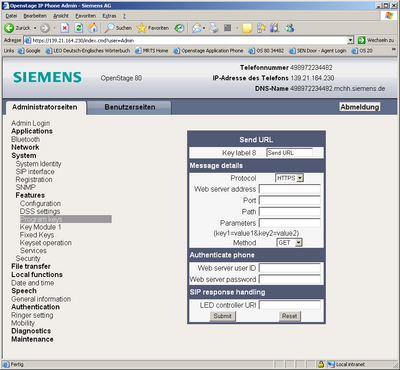Difference between revisions of "Free programmable Key (FPK) to send URL request to Server"
The Wiki of Unify contains information on clients and devices, communications systems and unified communications. - Unify GmbH & Co. KG is a Trademark Licensee of Siemens AG.
(→Configuration in Admin Menu) |
(→Configuration in Admin Menu) |
||
| Line 56: | Line 56: | ||
The parameters are mapped to the URL in the following way: | The parameters are mapped to the URL in the following way: | ||
| − | <method> <protocol>://< | + | <method> <protocol>://<web server user ID>:<web server password>@<web server address>:<port>/<path>?<parameters> |
== Example == | == Example == | ||
Revision as of 12:31, 17 September 2010
| Systematics | |
| Family: | OpenStage |
| Model: | OpenStage 40 OpenStage 60 OpenStage 80 |
| Relation: | Phone related |
| Release: | V2 R0 |
The basic requirement for the FPKs is that all keys (including those on any sidecar units attached) can be configured with a URL (termed send URL key). Pressing the key sends the URL to the server using an HTTP request. The key may be pressed at any time irrespective of registration and call state provid-ing the phone is not locked. The key has an associated LED, whose state may be controlled through SIP signalling.
The send URL key is configured at the Admin level through the configuration server and WBM (provid-ing the key function has not been locked down). It is not changeable through local phone menus or OSM. The phone user may only change the label associated with the key. They can not affect the con-figuration of the send URL key (either to configure or deconfigure them). The key function may be viewed via normal FPK editing. However, the URL and the associated data are not displayed.
A URL can only be assigned to non-shifted functions. It can not be assigned to the shifted functions. This ensures no conflicts between the different URLs and the single LED associated with the key.
Whilst the HTTP request is in progress, further key presses will be ignored. They will not send subse-quent URL requests to the server. If the HTTP request fails, a popup will be displayed, informing the user of the error. The normal priority rules for popups will apply. All key presses, URL sent, and re-sponse will be logged.
The supported protocols are HTTP and HTTPS. With HTTPS, the phone will authenticate the server and the server may authenticate the phone. This ensures functions on the server are only executed after proper authentication of the phone. The DLS interface is required to deliver the new certificates to the phone.
If the LED is configured for SIP control and the phone is not registered, the HTTP request will still be sent but the state of the LED is not updated.
Configuration in Admin Menu
| Key label: | Label of the Key |
| Protocol: | Protocol type. HTTP and HTTPS is supported |
| Web server address: | IP-address or domain name of the server |
| Port: | Portnumber of the addressed server port |
| Path: | Path to application URI |
| Parameters: | Parameters for the application server |
| Method: | HTTP method used (GET or POST is supported) |
| Web server user ID: | User name for authentication |
| Web server password: | Password for authentication |
| LED controller URI: | URI used from SIP server to control the LED |
The parameters are mapped to the URL in the following way:
<method> <protocol>://<web server user ID>:<web server password>@<web server address>:<port>/<path>?<parameters>
Example
| Key label: | Example |
| Protocol: | HTTP |
| Web server address: | 139.21.164.230 |
| Port: | 443 |
| Path: | main.cmd |
| Parameters: | page=WEBM_Admin_KeyModule1&lang=de&menu=000110000000000_99&user=Admin |
| Method: | GET |
| Web server user ID: | admin |
| Web server password: | 123456 |
| LED controller URI: | URI used from SIP server to control the LED |
Example:
GET https://admin:123456@139.21.164.230:443/main.cmd?page=WEBM_Admin_KeyModule1&lang=de&menu=000110000000000_99&user=Admin




